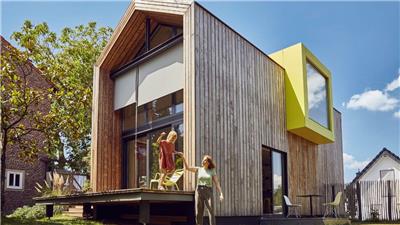Minimal, Simple, and Sustainable: Why Tiny Homes Are Going Big in America

As housing prices continue to rise, many people in the United States are veering toward a new-ish style of living space: the tiny house. According to a report by Investment Property Exchange Services, 73% of Americans would consider living in a tiny home.
These compact houses — often smaller than 500 square feet — have become more appealing to U.S. citizens, with affordability being a key factor. Tiny homes are also as sustainable as they are compact, drawing those looking to reduce their carbon footprint on the environment.
What Comprises a Tiny Home?
RubyHome estimates around 10,000 tiny homes are in the U.S.; or 0.36% of all residential listings.
While most would refer to living quarters smaller than 600 square feet as “tiny,” Appendix Q of the International Residence Code dictates that dwellings offering less than 400 square feet, excluding lofts, are “tiny homes.” Quicken Loans, however, says homes less than 500 square feet qualify. By both standards, that’s not a lot of space for storage.
Not all small residences are mobile homes, trailers, or repurposed tool sheds. Some tiny homes have permanent foundations. Portable properties, like trailers, allow these living spaces to move around, giving dwellers flexibility and travel freedom at the sacrifice of home staples like an organized garage or attic space.
Why a Tiny Home?
The American Dream is shifting from big family houses with white picket fences to modest 500-square-foot homes. IPX1031 research found that, of the 73% of Americans who would consider living in a tiny home, 75% are Gen Z and millennials.
The biggest reason behind the homes’ growing popularity is financial. The current housing market makes buying a standard home difficult for younger and financially unstable individuals. RubyHome says a tiny home typically costs buyers just $67,000 — 87% cheaper than what average shoppers shell out for standard houses.
Alongside elevated home pricing, sky-high interest rates push more than half of American consumers (52%) to consider alternative housing options like container homes, vans, and tiny homes. According to the IPX1031 study, 65% of U.S. citizens would consider buying a tiny home solely for financial reasons, and 86% consider them a good investment for first-time buyers.
The Freedoms of Tiny Living
Ultimately, cost-effective and sustainable tiny homes offer a financially practical solution over traditional homes’ by being more efficient and coming with lower overall expenses.
Compact homes boast a drastic reduction in maintenance costs and utility bills, as they consume less energy and leave a much smaller carbon footprint than a traditional home. These mini homes help consumers and first-time buyers save money and are more sustainable in the long run. Compact homes offer financial freedom, which attracts a diverse base of customers. They are the perfect solution for young professionals and single retirees who don’t need much space and often can’t afford conventional properties.
Freedom of movement is also a major factor. Buyers with trailer-hitched tiny homes can easily relocate, while those with more permanent foundations are immovable. Flexibility is increasingly important amid rising interest in “ digital nomadism,” or frequently-traveling remote workers. All of these factors are creating a housing market that’s slowly favoring tiny living more and more. The trend may not fade but continue growing as real estate prices soar.
Rising Interest in Alternative Living Spaces
Interest in alternative housing, like container homes, is ever-rising among Americans. These differently designed spaces can look unique for all families, encompassing converted vans, container homes, modular homes, and tiny homes.
Investment Property Exchange Services’ research finds the top 10 tiny-home states are Vermont, Wyoming, Alaska, Maine, Montana, North Dakota, South Dakota, New Hampshire, Arkansas, and Tennessee. The data also reveals 89% of Americans find these homes more appealing than traditional houses. Around 82% also see them as fruitful investments, with some comprising low-cost rentals for locals or vacation property listings through Airbnb or VRBO.
Among those investing in alternative living spaces, more than half (56%) use them as their primary residence. About two in five owners (41%) rent out the intimate space, while an estimated 70% own the land on which their home sits.
The numbers are quite staggering, as more than one in ten U.S. citizens plan to buy an alternative living space in the coming year. Of that, only 10% plan on purchasing just to list it for rent, leaving a sizable majority buying tiny homes as their next dwelling.
This article was produced by Media Decision and syndicated by Wealth of Geeks.
Copyright 2024 Wealth of Geeks